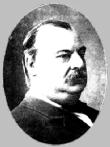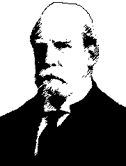|
An Inventory of Papers in Syracuse University Libraries© History
Osborne was acquainted with Walter Damrosch, corresponded with Melville Clark, and on one occasion conducted the Syracuse Symphony Orchestra. In spare moments he wrote closet drama. Later in life, as a prison warden, he encouraged inmates to produce musicals, while on other occasions he made them captives for one of his importations. He performed well in his studies at Harvard, graduating with honors in 1884.
The business sense he gained from his father disposed him to be among the founders of the Harvard Cooperative Society, but though he later kept careful accounts to survive for 20 years as a corporation executive, he detested the office of a businessman. In 1887, he assumed the presidency of his late father's company. He directed the firm Until 1903 when J.P. Morgan and associates purchased factories and stock for the international Harvester Trust Co. Osborne also held the positions of president in the Auburn Iron Works and the Cayuga County Dairy Co. and vice-president in the Eagle Wagon Works and the Columbian Rope Co. He was a principal stockholder of the National Bank of Auburn and one of its directors. In 1886 Osborne married Agnes Devens of Cambridge, Mass. They had four children, all boys: David Munson II, Charles Devens, Arthur Lithgow and Robert Klipfel. Agnes Devens died at 31, a month after giving birth to her fourth child. After losing his wife, Osborne channeled more energy into politics, philanthropy and social reform. In the first presidential election in which he had been eligible to vote he abandoned the Osborne heritage of Republicanism and the politics of James G. Blaine to support Grover Cleveland and the Democratic Party. Thereafter he was generally found among the Democrats, except for recurring intervals when his principles forced him into short-lived third parties or back to the fold of Republicans. In 1894 he was candidate for Lt. Governor of New York on the Citizen's Union ticket. As an eastern manufacturer, Osborne bolted Bryan's plank of "Free Silver" in 1896 and 1900; but when the silver issue was dead in 1908, Osborne returned to Bryan and the Democratic Party. When the Buffalo Democratic Convention (1906) nominated William Randolph Hearst for governor, Osborne was among the "Honor Democrats" who campaigned for the Republican, Charles Evans Hughes. With the patrician's contempt for Hearst's "hysterical journalism," Osborne denounced the publisher as a self-advertised "saviour" who played to the ignorance of the multitude while trading secretly with Tammany Hall and the trusts. Osborne went out on the stump for Hughes, who, when elected, rewarded Osborne with a seat on the Public Service Commission. Osborne worked for the Hughes administration two and a half years, during which he wrote two striking opinions against the New York Central Railroad. In the first case, he employed a tactic to which he reverted throughout his life: he obtained first-hand information by use of a disguise. Soon Commissioner Osborne was riding the rails in the rags of a hobo. Observing railroad procedures between New York and Albany, he perceived that the crews of heavy freights could not be reduced from six men to five without a loss of safety and that a second brakeman was essential for switching operations, especially at night.
In another decision, Osborne revealed an inclination to challenge wealth and power when they were used irresponsibly. His dissenting brief in the Buffalo, Rochester & Erie Railroad case argued against a continuation of the New York Central's monopoly along the westward route from Albany. He accepted the proposition that public service corporations confined to a small community might be maintained as "local monopolies" but he would not countenance a state-wide utility in private hands, "even with the curb of the Public Service Commission." According to Osborne, willing competitors like the B.R. & E. should not be discouraged by state agencies from challenging established monopolies. Public convenience and the state's network of transportation benefited from sound competition. Osborne resigned from the Public Service Commission to convene the Saratoga Conference, out of which emerged the Democratic League with Osborne as chairman. His political aspirations crested when Cayuga County put him forward as a gubernatorial candidate. He failed in the nomination of 1910 but remained with the Democratic Party. The winner and a lukewarm political ally, Governor John A. Dix, tucked him away as Forest, Fish and Game Commissioner, a post Osborne soon resigned. Osborne was a leader of the Democratic Party of Cayuga County and a factor in New York State politics between 1905 and 1912, when he canvassed the state for Woodrow Wilson. In his first campaign for mayor of Auburn, Osborne had breathed new life into local politics. Among his achievements, he introduced new efficiency into municipal administration and won a home rule charter for the city. As Osborne left the mayor's office in 1905, he founded the Auburn Publishing Co. Through its daily newspaper, The Auburn Citizen, he extended his influence as the prod behind Democratic successes upstate. His "political dynamite," as a Harvard friend called it, pushed national issues into the background and battered the Republican steamroller to a standstill. |
| The Osborne Family Inventory text 1971 by Syracuse University Libraries |



